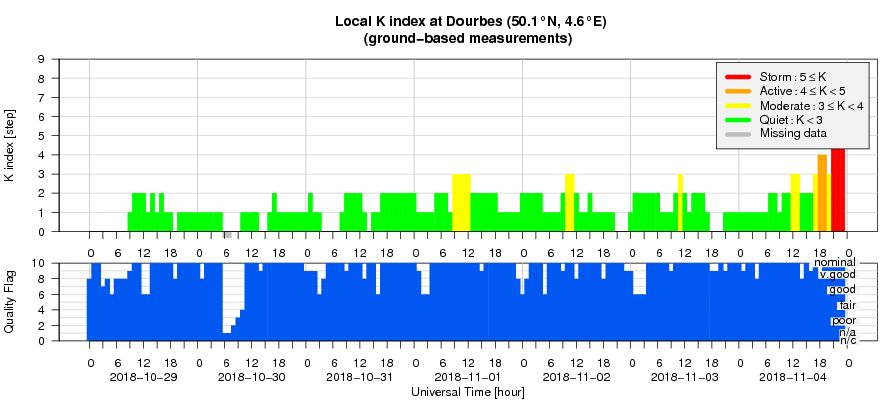- Table of Content
- 1.The ESWW medal...
- 2.PROBA2 Observa...
- 3.Review of sola...
- 4.The Internatio...
- 5.Geomagnetic Ob...
- 6.The SIDC space...
- 7.Review of iono...
2. PROBA2 Observations (29 Oct 2018 - 4 Nov 2018)
3. Review of solar and geomagnetic activity
4. The International Sunspot Number
5. Geomagnetic Observations at Dourbes (29 Oct 2018 - 4 Nov 2018)
6. The SIDC space weather Briefing
7. Review of ionospheric activity (29 Oct 2018 - 4 Nov 2018)
The ESWW medals are awarded
The new medal recipients were announced in the medal ceremony at the European Space Weather Week, the 5th of November, 2018
The International Kristian Birkeland medal for Space Weather and Space Climate for outstanding scientific or technological results and is attributed to Professor Tamas Gombosi.
The International Marcel Nicolet medal for Space Weather and Space Climate rewards efforts to structure the space weather community at an international level and is attributed to Professor Hermann J Opgenoorth.
The International Alexander Chizhevsky medal for Space Weather and Space Climate rewards a young researcher for major contributions to space weather research and/or services and is attributed to Dr. Christina Kay.
more about the winners: http://www.stce.be/esww15/medals.php

PROBA2 Observations (29 Oct 2018 - 4 Nov 2018)
Solar Activity
Solar flare activity remained very low during the week.
In order to view the activity of this week in more detail, we suggest to go to the following website from which all the daily (normal and difference) movies can be accessed: http://proba2.oma.be/ssa
This page also lists the recorded flaring events.
A weekly overview movie can be found here (SWAP week 449): http://proba2.oma.be/swap/data/mpg/movies/weekly_movies/weekly_movie_2018_10_29.mp4
Details about some of this week's events, can be found further below.
Thursday Nov 01
If any of the linked movies are unavailable they can be found in the P2SC movie repository here: http://proba2.oma.be/swap/data/mpg/movies/
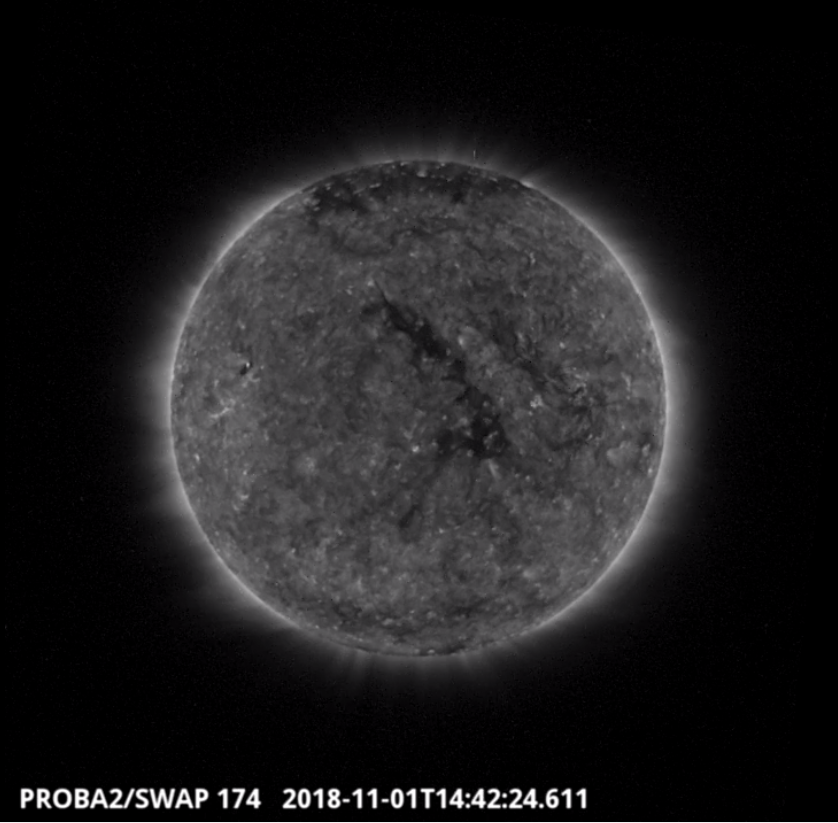
A small transient dimming was observed by SWAP on 2018-Nov-01, visible in the east of the solar disk in the SWAP image above taken at 14:42 UT.
Find a movie of the event here (SWAP movie): http://proba2.oma.be/swap/data/mpg/movies/20181101_swap_movie.mp4
Review of solar and geomagnetic activity
SOLAR ACTIVITY
Solar activity was at very low levels. The solar disk was spotless for the entire week.
No earth-directed coronal mass ejections (CMEs) were observed.
The greater than 10 MeV proton flux was at nominal levels.
Two equatorial coronal holes (CH) transited the central meridian: a small negative polarity CH on 27-28 October, and a larger, positive polarity CH on 31 October - 02 November.
GEOMAGNETIC ACTIVITY
Solar wind speed undulated between 285 and 365 km/s. Bz was variable between -5 and +5 nT. The direction of the interplanetary magnetic field (IMF) was predominately in a negative sector. The wind stream associated to the small negative polarity CH left no obvious obvious signature in the solar wind parameters.
Around 09:30UT on 4 November, the IMF gradually turned into a positive sector. Bz became increasingly negative, reaching -10 nT around 17UT and oscillating between -12 and +12 nT for the remainder of the period. Solar wind speed started a gradual increase around 14:30UT, ending the week near 500 km/s. The evolution of the solar wind parameters were indicative of the arrival of the the co-rotating interaction region and the high speed wind stream (HSS) associated with the positive polarity equatorial CH.
Quiet geomagnetic conditions were observed for most of the period, with a single active interval recorded by Dourbes on 1, 2 and 3 November. Late on 4 November, under the influence of the positive polarity CH HSS, geomagnetic activity reached minor storming levels (K = 5).
The International Sunspot Number
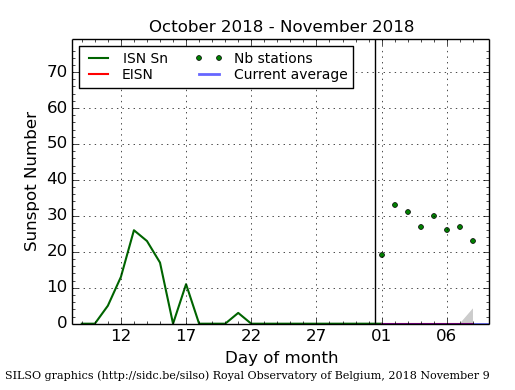
The daily Estimated International Sunspot Number (EISN, red curve with shaded error) derived by a simplified method from real-time data from the worldwide SILSO network. It extends the official Sunspot Number from the full processing of the preceding month (green line). The plot shows the last 30 days (about one solar rotation). The horizontal blue line shows the current monthly average, while the green dots give the number of stations included in the calculation of the EISN for each day.
The SIDC space weather Briefing
The Space Weather Briefing presented by the forecaster on duty from Oct 29 to Nov 4. It reflects in images and graphs what is written in the Solar and Geomagnetic Activity report.
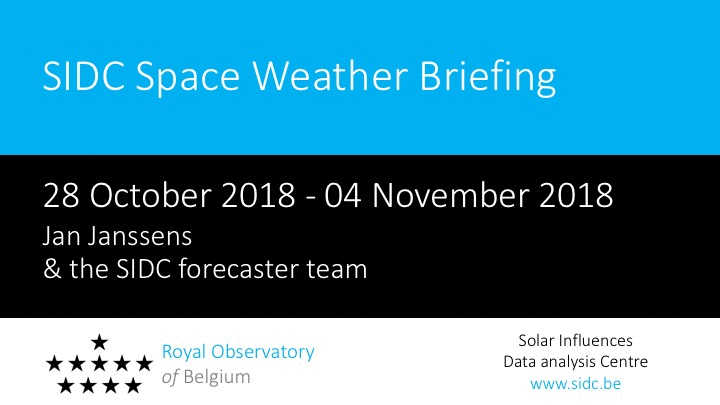
pdf-version: http://www.stce.be/briefings/20181105_SWbriefing.pdf
automatically running presentation: http://www.stce.be/briefings/20181105_SWbriefing.ppsm
Review of ionospheric activity (29 Oct 2018 - 4 Nov 2018)
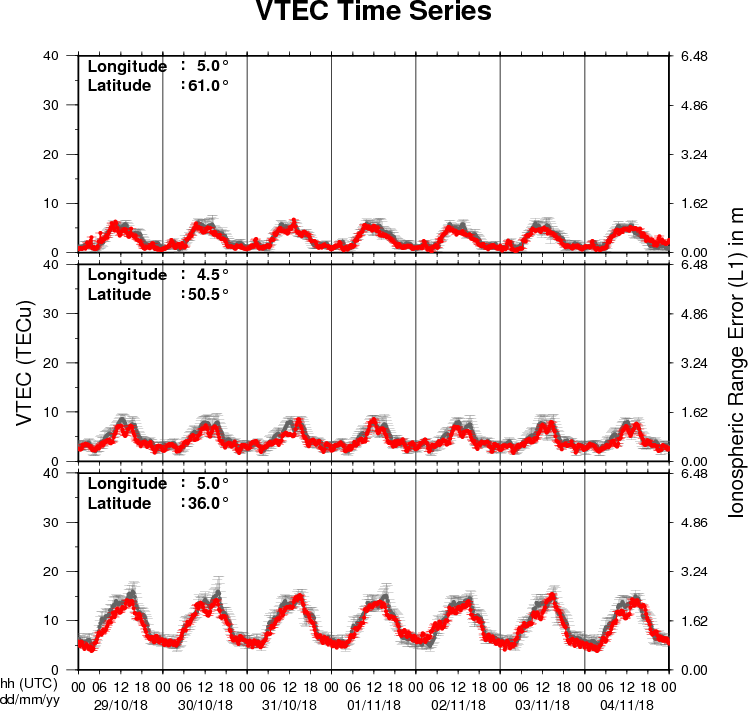
The figure shows the time evolution of the Vertical Total Electron Content (VTEC) (in red) during the last week at three locations:
a) in the northern part of Europe(N61°, 5°E)
b) above Brussels(N50.5°, 4.5°E)
c) in the southern part of Europe(N36°, 5°E)
This figure also shows (in grey) the normal ionospheric behaviour expected based on the median VTEC from the 15 previous days.
The VTEC is expressed in TECu (with TECu=10^16 electrons per square meter) and is directly related to the signal propagation delay due to the ionosphere (in figure: delay on GPS L1 frequency).
The Sun's radiation ionizes the Earth's upper atmosphere, the ionosphere, located from about 60km to 1000km above the Earth's surface.The ionization process in the ionosphere produces ions and free electrons. These electrons perturb the propagation of the GNSS (Global Navigation Satellite System) signals by inducing a so-called ionospheric delay.
See http://stce.be/newsletter/GNSS_final.pdf for some more explanations ; for detailed information, see http://gnss.be/ionosphere_tutorial.php
